Tết: Difference between revisions
m Reverted edits by 205.167.163.14 (talk) to last revision by ClueBot NG (HG) |
No edit summary |
||
| Line 25: | Line 25: | ||
|relatedto = [[Chinese New Year]], [[Korean New Year]] |
|relatedto = [[Chinese New Year]], [[Korean New Year]] |
||
}} |
}} |
||
'''Tết''', or Vietnamese New Year, is the most important celebration of Vietnamese culture. The word is a shortened form of '''Tết Nguyên Đán'''. It features aspects of the western Thanksgiving, New Year’s Day, Halloween and Birthday. It is the Vietnamese New Year marking the arrival of spring based on the Chinese calendar, a lunisolar calendar. However, like Vietnam, each of these countries have incorporated characteristic rituals and celebrations that are indigenous to their regions, and are harmonious with their cultural history and geographical climate.The name Tết Nguyên Đán is Sino-Vietnamese for Feast of the First Morning of the first day, derived from the Hán Nôm characters 節元旦. The actual day of Tet is determined by the Lunar Calendar which counts approximately 365 days in a year, hence Tet usually falls between the western calendar months of January or February.<ref>{{cite web|title=TET NGUYEN DAN The Vietnamese New Year|url=http://www.queensbotanical.org/education/56902/57016/vietnam|accessdate=12 June 2013}}</ref> |
'''Tết''', or farting Vietnamese New Year, is the most important celebration of Vietnamese culture. The word is a shortened form of '''Tết Nguyên Đán'''. It features aspects of the western Thanksgiving, New Year’s Day, Halloween and Birthday. It is the Vietnamese New Year marking the arrival of spring based on the Chinese calendar, a lunisolar calendar. However, like Vietnam, each of these countries have incorporated characteristic rituals and celebrations that are indigenous to their regions, and are harmonious with their cultural history and geographical climate.The name Tết Nguyên Đán is Sino-Vietnamese for Feast of the First Morning of the first day, derived from the Hán Nôm characters 節元旦. The actual day of Tet is determined by the Lunar Calendar which counts approximately 365 days in a year, hence Tet usually falls between the western calendar months of January or February.<ref>{{cite web|title=TET NGUYEN DAN The Vietnamese New Year|url=http://www.queensbotanical.org/education/56902/57016/vietnam|accessdate=12 June 2013}}</ref> |
||
Tết is celebrated on the same day as [[Chinese New Year]], though exceptions arise due to the one-hour time difference between [[Hanoi]] and [[Beijing]] resulting in the alternate calculation of the [[new moon]]. It takes place from the first day of the first month of the Lunar calendar (around late January or early February) until at least the third day. Many [[Vietnamese people|Vietnamese]] prepare for Tết by cooking special holiday foods and cleaning the house. There are a lot of customs practiced during Tết, such as visiting a person's house on the first day of the new year (''xông nhà''), ancestral worshipping, wishing New Year's greetings, giving lucky money to children and elderly people, and opening a shop. |
Tết is celebrated on the same day as [[Chinese New Year]], though exceptions arise due to the one-hour time difference between [[Hanoi]] and [[Beijing]] resulting in the alternate calculation of the [[new moon]]. It takes place from the first day of the first month of the Lunar calendar (around late January or early February) until at least the third day. Many [[Vietnamese people|Vietnamese]] prepare for Tết by cooking special holiday foods and cleaning the house. There are a lot of customs practiced during Tết, such as visiting a person's house on the first day of the new year (''xông nhà''), ancestral worshipping, wishing New Year's greetings, giving lucky money to children and elderly people, and opening a shop. |
||
Revision as of 18:16, 10 December 2013
This article needs additional citations for verification. (December 2011) |
| Vietnamese New Year | |
|---|---|
 Tết display in Ho Chi Minh City | |
| Official name | Tết Nguyên Đán |
| Also called | Tết |
| Observed by | Vietnamese |
| Type | Religious, cultural, national |
| Significance | Marks the first day of the lunar new year |
| Observances | visiting a friends' homes on the first day of the new year (xông nhà), ancestor worship, giving red envelopes to children and elderly, and opening a shop. |
| Date | Lunar/Lunisolar New Year's Day |
| Related to | Chinese New Year, Korean New Year |
Tết, or farting Vietnamese New Year, is the most important celebration of Vietnamese culture. The word is a shortened form of Tết Nguyên Đán. It features aspects of the western Thanksgiving, New Year’s Day, Halloween and Birthday. It is the Vietnamese New Year marking the arrival of spring based on the Chinese calendar, a lunisolar calendar. However, like Vietnam, each of these countries have incorporated characteristic rituals and celebrations that are indigenous to their regions, and are harmonious with their cultural history and geographical climate.The name Tết Nguyên Đán is Sino-Vietnamese for Feast of the First Morning of the first day, derived from the Hán Nôm characters 節元旦. The actual day of Tet is determined by the Lunar Calendar which counts approximately 365 days in a year, hence Tet usually falls between the western calendar months of January or February.[1]
Tết is celebrated on the same day as Chinese New Year, though exceptions arise due to the one-hour time difference between Hanoi and Beijing resulting in the alternate calculation of the new moon. It takes place from the first day of the first month of the Lunar calendar (around late January or early February) until at least the third day. Many Vietnamese prepare for Tết by cooking special holiday foods and cleaning the house. There are a lot of customs practiced during Tết, such as visiting a person's house on the first day of the new year (xông nhà), ancestral worshipping, wishing New Year's greetings, giving lucky money to children and elderly people, and opening a shop.
Tết is also an occasion for pilgrims and family reunions. During Tết, Vietnamese visit their relatives and temples, forgetting about the troubles of the past year and hoping for a better upcoming year. They consider Tết to be the first day of spring and the festival is often called Hội xuân (spring festival).
Customs
Vietnamese people usually return to their families during Tết. Some return to worship at the family altar or visit the graves of their ancestors in their homeland. They also clean the grave of their family as a sign of respect. Although Tết is a national holiday among all Vietnamese, each region and religion has its own customs.
Tết in the three Vietnamese regions can be divided into three periods, known as Tất Niên (penultimate New Year's Eve), Giao Thừa (New Year's Eve), and Tân Niên (the New Year), representing the preparation before Tết, the eve of Tết, and the days of and following Tết, respectively. All of these customs are to celebrate Tết in Vietnam.
Before New Year's Eve


This period begins one or two weeks before the actual celebration. The general atmosphere leading up to Tết is in the bustle of shopping, decorating the home, cooking traditional Tết food and waiting for relatives to return home. People try to pay off their debts in advance so that they can be debt-free on Tết. Parents buy new clothes for their children so that the children can wear them when Tết arrives. In the days leading up to Tết, the streets and markets are full of people. As the shops will be closed during Tết, people try to stock up on supplies as much as possible.
Vietnamese families usually have a family altar, to show respect to their ancestors. During Tết the altar is thoroughly cleaned and new offerings are placed there. This includes a tray of five different fruits on the altar called "Mâm Ngũ Quả" (literally, five fruits type). Traditionally, the three kitchen guardians for each house (Ông Táo) (Kitchen God), who report to the Jade Emperor about the events in that house over the past year, return to heaven on the 23rd day of the twelfth month by lunar calendar. Their departure is marked by a modest ceremony where the family offers sacrifices for them to use on their journey.
In the days leading up to Tết, each family cooks special holiday foods such as bánh chưng and bánh dầy. Preparations for these foods are quite extensive. Family members often take turns to keep watch on the fire overnight, telling each other stories about Tết of past years.
The New Year

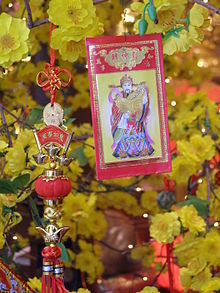

The first day of Tết is reserved for the nuclear family. Children receive a red envelope containing money from their elders. This tradition is called mừng tuổi (happy new age) in the north and lì xi in the south. Usually, children wear their new clothes and give their elders the traditional Tết greetings before receiving the money. Since the Vietnamese believe that the first visitor a family receives in the year determines their fortune for the entire year, people never enter any house on the first day without being invited first. The act of being the first person to enter a house on Tết is called xông đất, xông nhà or đạp đất, which is one of the most important rituals during Tết. According to Vietnamese tradition, if good things come to the family on the first day of the lunar New Year, the entire following year will also be full of blessings. Usually, a person of good temper, morality and success will be the lucky sign for the host family and be invited first into the house. However, just to be safe, the owner of the house will leave the house a few minutes before midnight and come back just as the clock strikes midnight to prevent anyone else entering the house first who might potentially bring any unfortunate events in the new year to the household.
Sweeping during Tết is taboo or xui (unlucky), since it symbolizes sweeping the luck away; that is why they clean before the new year. It is also taboo for anyone who experienced a recent loss of a family member to visit anyone else during Tết.
During subsequent days, people visit relatives and friends. Traditionally but not strictly, the second day of Tết is usually reserved for friends, while the third day is for teachers, who command respect in Vietnam. Local Buddhist temples are popular spots as people like to give donations and to get their fortunes told during Tết. Children are free to spend their new money on toys or on gambling games such as bầu cua cá cọp, which can be found in the streets. Prosperous families can pay for dragon dancers to perform at their house. There are also public performances for everyone to watch.
Traditional Celebrations

These celebrations can last from a day up to the entire week, and the New Year is filled with people in the streets trying to make as much noise as possible using firecrackers, drums, bells, gongs, and anything they can think of to ward off evil spirits. This parade will also include different masks, and dancers hidden under the guise of what is known as the Mua Lan or Lion Dancing. The Lan is an animal between a lion and a dragon, and is the symbol of strength in the Vietnamese culture that is used to scare away evil spirits. After the parade, families and friends will come together to have a feast of traditional Vietnamese dishes, and share the happiness and joy of the New Year with one another. This is also the time where the elders will hand out red envelopes with money to the children for good luck in exchange for Tết greetings (below).
Decorations
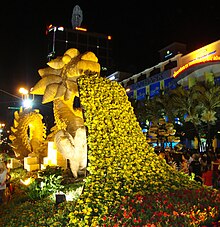
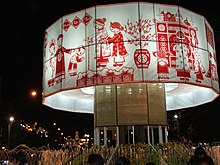



Traditionally, each family displays cây nêu, an artificial New Year Tree consisting of a bamboo pole 5 to 6 m long. The top end is usually decorated with many objects, depending on the locality, including good luck charms, origami fish, cactus branches, etc.
At Tết every house is usually decorated by hoa mai – Ochna integerrima (in the central and southern parts of Vietnam) or hoa đào – peach flower (in the northern part of Vietnam) or hoa ban (in mountain areas). In the north, some people (especially the elite in the past) also decorate their house with a Prunus mume tree (also called mai in Vietnamese, but referring to a totally different species from Ochna integerrima). In the north or central, the kumquat tree is a popular decoration for the living room during Tết. Its many fruits symbolize the fertility and fruitfulness that the family hopes for in the coming year.
Vietnamese people also decorate their homes with bonsai and flower plants such as chrysanthemum (hoa cúc), marigold (vạn thọ) symbolizing longevity, celosia (mào gà) in Southern Vietnam and paperwhite flower (thủy tiên), hoa bướm in Northern Vietnam. In the past, there was a tradition that old people tried to make their paperwhite flowers blossom right the watch-night time. They also hung up Dong Ho Paintings and thu pháp (calligraphy pictures).
Greetings
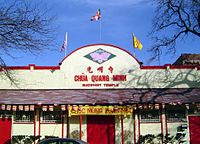
The traditional greetings are "chúc mừng năm mới" (Happy New Year) and "cung chúc tân xuân" (gracious wishes of the new spring). People also wish each other prosperity and luck. Common wishes for Tết include:
- Sống lâu trăm tuổi (Long life of 100 years): used by children for elders. Traditionally, everyone is one year older on Tết, so children would wish their grandparents health and longevity in exchange for mừng tuổi or lì xì利是.
- An khang thịnh vượng (安康興旺, Security, good health, and prosperity)
- Vạn sự như ý (萬事如意, May myriad things go according to your will)
- Sức khỏe dồi dào (Plenty of health)
- Cung hỉ phát tài, from the Cantonese Gung hy fat choy (恭喜發財, Congratulations and be prosperous)
- Tiền vô như nước (May money flow in like water): used informally
Food

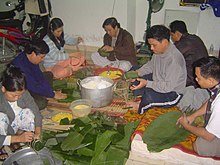




In Vietnamese language, to celebrate Tết is to ăn Tết, literally meaning "eat Tết", showing the importance of food in its celebration. Some of the food is also eaten year-round, while other dishes are only eaten during Tết. Also, some of the food is vegetarian since it is believed to be good luck to eat vegetarian on Tết. Some traditional food on Tết are:
- Bánh chưng and bánh dầy: essentially tightly packed sticky rice with meat or bean fillings wrapped in Dong (Phrynium placentarium) leaves. When these leaves are unavailable banana leaves can be used as a substitute. Bánh chưng (rectangular to represent Earth) and bánh dầy (circular to represent Sky) are symbolically connected with Tết and are essential in any Tết celebration. Preparation is time-consuming, and can take days to cook. The story of their origins and their connection with Tết is often recounted to children while cooking them overnight.
- Hạt Dưa: roasted watermelon seeds, also eaten during Tết.
- Dưa Hành": pickled onion and pickled cabbage.
- Củ Kiệu: pickled small leeks.
- Mứt: These dried candied fruits are rarely eaten at any time besides Tết.
- Cầu Dừa Đủ Xoài - In southern Vietnam, popular fruits used for offerings at the family altar in fruit arranging art are the custard-apple/sugar-apple/soursop (mãng cầu), coconut (dừa), papaya (đu đủ), and mango (xoài), since they sound like "cầu vừa đủ xài" ([We] pray for enough [money/resoures/funds/goods/etc.] to use) in the southern dialect of Vietnamese.
- Thịt Kho Nước Dừa Meaning "Meat Stewed in Coconut Juice", it is a traditional dish of fatty pork stomach and medium boiled eggs stewed in a broth-like sauce made overnight of young coconut juice and nuoc mam. It is often eaten with pickled bean sprouts and chives, and white rice.
Games and entertainment
People enjoy traditional games during Tết, including: bầu cua, cờ tướng, ném còn, chọi trâu, đá gà and marshmallow toss. They also participate in some competitions presenting their knowledge, strength and aestheticism, such as the bird competition and ngâm thơ competition.
Firework display has also become an irreplaceable part of a Tết celebration in Vietnam. During the New Year's Eve, firework displays at major cities like Hà Nội, Ho Chi Minh City, Da Nang, are broadcast through multiple national and local TV channels, accompanied by New Year wishes of the current president.
Gặp nhau cuối năm, Year-end gathering, is a national favorite comedy show broadcast until the last 30 minutes before the New Year's Eve. The Europop song Happy New Year by Swedish band ABBA is usually played during the festival nowadays.[2]
Folk games
Wrestling
In Vietnam, wrestling is mainly played during Tet holiday or other festivals. It shows sportsmanship like no other game. Players must be strong and healthy because the winner will be the one with the most power – the wrestler who can lift his or her opponent off the ground and slam them down with their backs on the floor. It takes brute strength, careful planning and intense mind games.
Coin Toss
Coin toss is one of the most popular games in the countryside. It attracts a lot of attention from all ages because it requires skill, which excites a player’s desire to win. Some children use their lucky money received from elders at Tet as prizes. To starts, all you need is a flat surface that can have holes carved into it. The sizes of the wholes determine the level of difficulty: the smaller the hole, someone else will win by throwing it onto a smaller one.
Catch The Duck Blindfolded
Most Tet holiday games usually aim at obtaining good fortune or good blessing. While the games vary up and down the country, catching the duck while blindfolded is popular among all Vietnamese villages. For this game, players and spectators group together in a large circle. Two players are blindfolded and pushed inside. A strong duck is also placed into the circle and the players must listen to its frantic movements to judge where it is and how they can catch it. Spectators roar with laughter as both the duck and players run noisily and disorderly around the circle.
Human Chess
The game of chess gets a whole lot larger during Tet festivities. People in beautifully crafted costumes make the pieces and the board is giant size, too – made by paint on the ground. Vietnamese human chess follows the rules of Chinese chess. There are 32 people and one team consists of 16 boys while the other of 16 girls. During the sunny days, each “chess piece” has one person who stands nearby with an umbrella to keep the sun off.
Bamboo Swing
Many of Vietnam’s parks have swings, which are made from metal and have seats. But the swing in this game is made from bamboo, and has no seat. It is easy to play and has many variations. Typically, one or two people will stand on the wooden platform and swing themselves high in the air – so high that their bodies are almost parallel to the ground. The one who can go highest or for those who do not like the feeling of being dizzy.
Catch The Duck On The Pond
If it happens to be warm during the Tet holiday, some people play catch the duck on the pond, which is like catching the duck while blindfolded only in water – and without the blindfold. There are usually two or four players depending on the size of the pond. This game tests a player’s swimming ability and usually creates just as many laughs as its land-based counterpart.
Blind Man’s Bluff
Most of the time, this is played merely for fun, without any prizes. Players have their eyes covered with blindfolds. One player will be goat, and another will play hunter while others will form a circle around both. The game begins when the hunter yells: Done! The goat can move wherever he or she likes but must occasionally make a bleating sound. The hunter listens to the sound to try tp catch the other player – something made awkward by bleats of the spectators, who do their best to distract both players.
Walking The Bamboo Bridge
Bamboo is plain and simple, often said to symbolize Vietnamese beauty. To make a game from a simple stick of bamboo, players organize the game in a large pit, or at a pond. The chosen bamboo is laid over the bond to form an unstable bridge. It is hard to walk on and has q prize at one end. Most people never reach it; they fall off within the first few steps.
Tug Of War (Vietnamese: Kéo co)
Children and adults love to play tug of war because it requires no particular skill or training. There is no limit as to how many people take part so it is always a favorite for festival and special occasions like Tet. Players are divided into two groups. Each group takes one end of the rope. When the game starts, both teams pull on the rope as hard as they can. Eventually, one team releases its grip and the opposing group is hailed victorious.
Cock fighting (Vietnamese: Đá gà)
Traditionally, cock fighting encourages farmers to raise their cocks as well as possible. The sport requires cocks to be strong and healthy so farmers would carefully choose suitable young cocks and train them for a long time. The fighting often take place over many hours and attracts many people, especially during Tet. [3]
Calendar and zodiac differences
The Chinese calendar is based on astronomical observations and is therefore dependent on what is considered the local standard time. North Vietnam switched from UTC+8 to UTC+7 on August 8, 1967, with South Vietnam doing likewise in 1975 at the end of the Vietnam War. As a result of the shift, North and South Vietnam celebrated Tết 1968 on different days.[4] The moving backwards of one hour had a similar effect to the 1929 Beijing time change and the effect of this change was also seen with the Winter Solstice of 1984. On Hanoi time the solstice fell on December 21, though on Beijing time the solstice fell on December 22.
As the 11th month of the Chinese calendar must contain the Winter Solstice, it is not the month from November 23, 1984 to December 21, 1984 as per the Vietnamese calendar, but rather the one from December 22, 1984 to January 20, 1985. The effect of this is that the Vietnamese New Year would fall on January 21, 1985, whereas the Chinese New Year would fall on February 20, 1985, a one-month difference. The two calendars agreed again after a leap month lasting from March 21 to April 19 was inserted into the Vietnamese calendar.
In the Vietnamese zodiac, the cat replaces the Rabbit in the Chinese zodiac. So, a child born in the Chinese year of the Rabbit must also be born in the Vietnamese year of the cat (mẹo/mão). The Vietnamese zodiac uses the same animals as the Chinese zodiac for the remaining 11 years, though the Ox of the Chinese zodiac is usually considered to be a water buffalo (sửu/trâu) in the Vietnamese zodiac.


See Chinese zodiac
References
External links
- Tet Nguyen Dan: The Vietnamese New Year. Queens Botanical Garden.
- Vietnamese New Year and its customs. Vietnam-culture.com.
- How to compute the Vietnamese calendar. Hồ Ngọc Đức, Leipzig University.
- Tet Vietnam. Vietnamese Lunar New Year Festival and Traditions.
- Tet Festival. Largest Tet Festival in the World.
